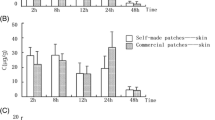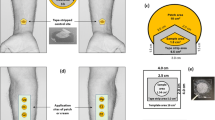Summary
The extent of metabolism of diclofenac sodium in excised viable human skin was investigated using combination HPLC and radioactivity assay. In an earlier diffusion experiment using anin vitro flow-through diffusion system, radiolabelled diclofenac sodium in either lotion (PennsaidPR) or aqueous solution was applied to viable human skin, either as single dose or multiple dose (8 times over 2 days). In this study, the receptor fluid samples from the diffusion experiment were subjected to extraction and the aliquot was analysed using HPLC to separate diclofenac and authentic metabolites. Based on the radioactivity of each HPLC fraction, the collection time of the fractions was compared with the retention time of diclofenac and metabolites in standard solutions. The samples from a single or multiple dose application of lotion showed radioactivity in mainly one fraction, whose retention time corresponded with diclofenac. Other HPLC fractions showed none or only small amounts of radioactivity within the error range of the assay. The same results were obtained with the pooled samples from the application of the lotion or of aqueous solution. The results suggest that diclofenac sodium does not undergo metabolism in viable human epidermis during percutaneous absorptionin vitro. Hence, with topical application to human skinin vivo, diclofenac will be delivered with minimal, if any, metabolism.
Similar content being viewed by others
References
Seth B.L. (1992): Comparative pharmacokinetics and bioavailability study of percutaneous absorption of diclofenac from two topical formulations containing drug as a solution gel and as an emulsion gel. Arzneimitellforschung, 42, 120–122.
Ho H.O., Huang F.C., Sokoloski T.D. et al. (1994): The influence of cosolvents on thein vitro percutaneous penetration of diclofenac sodium from a gel system. J. Pharm. Pharmacol., 46, 636–642.
Sioufi A., Pommier F., Boschet F. et al. (1994): Percutaneous absorption of diclofenac in healthy volunteers after single and repeated topical application of diclofenac emulgel. Biopharm. Drug Dispos., 15, 441–449.
Vyas S.P., Singh R., Asati R.K. (1995): Liposomally encapsulated diclofenac for sonophoresis induced systemic delivery. J. Microencapsulation, 12, 149–154.
Nishihata T., Kotera K., Nakano Y. et al. (1987): Rat percutaneous transport of diclofenac and influence of hydrogenated soya phospholipids. Chem. Pharm. Bull., 35, 3807–3812.
Obata Y., Takayama K., Okabe H. et al. (1991): Effect of cyclic monoterpenes on percutaneous absorption in the case of a water soluble drug (diclofenac sodium). Drug Des. Delivery, 6, 319–328.
Nishihata T., Kamada A., Takahashi K. et al. (1988): Percutaneous absorption of diclofenac in rats and humans: aqueous gel formulation. Int. J. Pharm., 46, 1–7.
Hewitt P.G., Poblete N., Wester R.C. et al. (1998):In vitro cutaneous disposition of a topical diclofenac lotion in human skin: effect of a multi-dose regimen. Pharm. Res., 15, 988–992.
Hui X., Hewitt P.G., Poblete N. et al. (1998):In vivo bioavailability and metabolism of topical diclofenac lotion in human volunteers. Pharm. Res., 15, 1589–1595.
Stierlin H., Faigle J.W., Sallmann A. et al. (1979): Biotransformation of diclofenac sodium (Voltaren*) in animals and in man. I. Isolation and identification of principal metabolites. Xenobiotica, 9, 601–610.
Stierlin H., Faigle J.W. (1979): Biotransformation of diclofenac sodium (Voltaren*) in animals and in man. II. Quantitative determination of the unchanged drug and principal phenolic metabolites, in urine and bile. Xenobiotica, 9, 611–621.
Wester R.C., Christoffel J., Hartway T. et al. (1998): Human cadaver skin viability forin vitro percutaneous absorption: Storage and detrimental effects of heat-separation and freezing. Pharm. Res., 15, 82–84.
Schneider W., Degen P.H. (1986): Simultaneous determination of diclofenac sodium and its metabolites in plasma by capillary gas chromatography with electroncapture detection. J. Chromatogr., 383, 412–418.
El-Sayed Y.M., Abdel-Hameed M.E., Suleiman M.S. et al. (1988): A rapid and sensitive high-performance liquid chromatographic method for determination of diclofenac sodium in serum and its use in pharmacokinetic studies. J. Pharm. Pharmacol., 40, 727–729.
Godbillon J., Gauron S., Metayer J.P. (1985): High-performance liquid chromatographic determination of diclofenac and its monohydroxylated metabolites in biological fluids. J. Chromatogr., 338, 151–159.
Schmitz G., Lepper H., Estler C.J. (1993): High-performance liquid chromatographic method for the routine determination of diclofenac and its hydroxy and methoxy metabolites fromin vitro systems. J. Chromatogr., 620, 158–163.
Lansdorp D., Janssen T.J., Guelen P.J.M. et al. (1990): High-performance liquid chromatographic method for the determination of diclofenac and its hydroxy metabolites in human plasma and urine. J. Chromatogr., 528, 487–494.
Author information
Authors and Affiliations
Rights and permissions
About this article
Cite this article
Tanojo, H., Wester, R.C., Shainhouse, J.Z. et al. Diclofenac metabolic profile followingin vitro percutaneous absorption through viable human skin. Eur. J. Drug Metab. Pharmacokinet. 24, 345–351 (1999). https://doi.org/10.1007/BF03190043
Received:
Issue Date:
DOI: https://doi.org/10.1007/BF03190043




